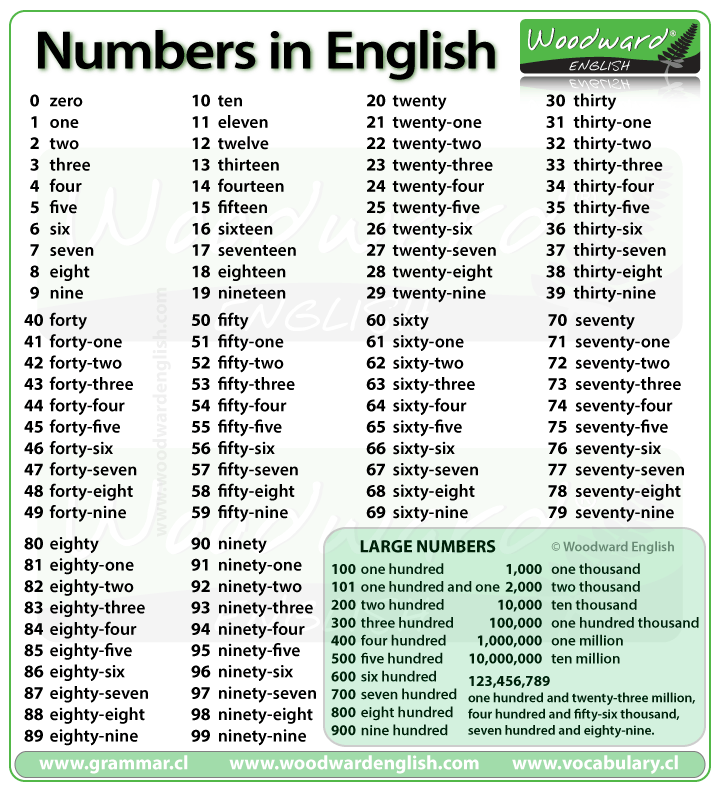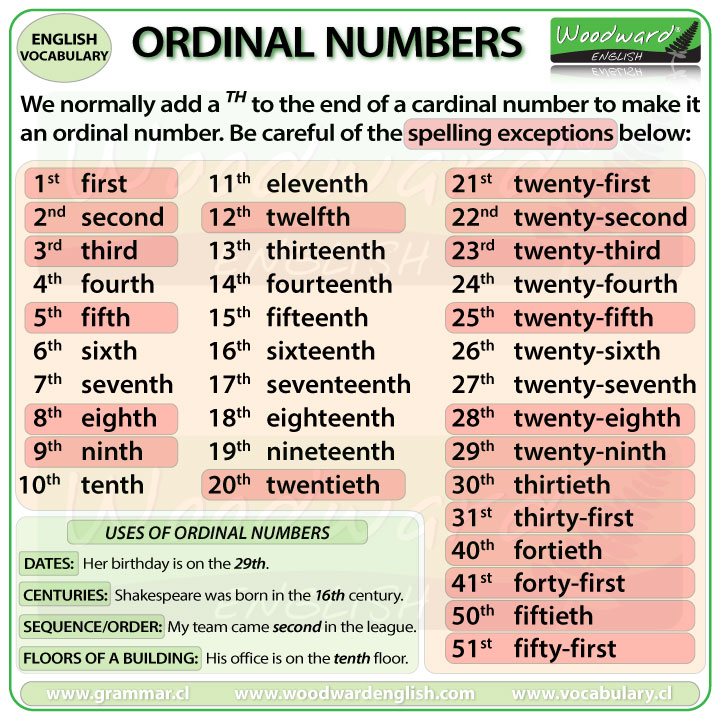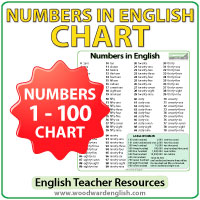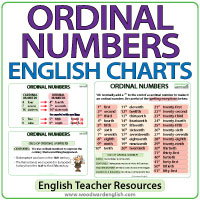Numbers in English
Learn English Vocabulary
There are two main types of numbers:
Cardinal Numbers - 1 (one), 2 (two) etc. (Used mainly for counting)
Ordinal Numbers - 1st (first), 2nd (second) etc. (Used mainly for putting things in a sequence)
Cardinal Numbers
Cardinal numbers are normally used when you:
- count things: I have two brothers. There are thirty-one days in January.
- give your age: I am thirty-three years old. My sister is twenty-seven years old.
- give your telephone number: Our phone number is two-six-three, three-eight-four-seven. (481-2240)
- give years: She was born in nineteen seventy-five (1975). America was discovered in fourteen ninety-two
Notice how we divide the year into two parts. This is the form for year up to 1999. For the year 2000 and on, we say two thousand (2000), two thousand and one (2001), two thousand and two (2002) etc.
Ordinal Numbers
You can normally create Ordinal numbers by adding -TH to the end of a Cardinal Number.
Ordinal numbers are normally used when you:
- give a date: My birthday is on the 27th of January. (Twenty-seventh of January)
- put things in a sequence or order: Liverpool came second in the football league last year.
- give the floor of a building: His office is on the tenth floor.
- have birthdays: He had a huge party for his twenty-first birthday.
- refer to centuries: Shakespeare was born in the 16th century.
For the name of a king or queen in written English, Roman numerals are used = Henry VIII
but in Spoken English you would say Henry the Eighth.
Cardinal Numbers
Listen to the pronunciation of the numbers from 1 to 100 in the following video:
Here is a list of cardinal numbers in English
- 1 - one
- 2 - two
- 3 - three
- 4 - four
- 5 - five
- 6 - six
- 7 - seven
- 8 - eight
- 9 - nine
- 10 - ten
- 11 - eleven
- 12 - twelve
- 13 - thirteen
- 14 - fourteen
- 15 - fifteen
- 16 - sixteen
- 17 - seventeen
- 18 - eighteen
- 19 - nineteen
- 20 - twenty
- 21 - twenty-one
- 22 - twenty-two
- 23 - twenty-three
- 30 - thirty
- 40 - forty
- 50 - fifty
- 60 - sixty
- 70 - seventy
- 80 - eighty
- 90 - ninety
- 100 - one hundred*
- 101 - one hundred and one
- 200 - two hundred
- 300 - three hundred
- 1000 - one thousand
- 1,000,000 - one million
- 10,000,000 - ten million
* Instead of saying One Hundred, you can say A hundred.
e.g. (127) one hundred and twenty-seven OR (127) a hundred and twenty-seven.
The same rule applies for one thousand (a thousand) and one million (a million)
Notice that you need to use a hyphen (-) when you write the numbers between 21 and 99.
With long numbers, we usually divide them into groups of three which are divided by a comma. e.g. 5000000 (5 million) is normally written as 5,000,000

Version of this chart for Parents and Teachers (each purchase helps us to create more free ESL material)
Números en inglés (for Spanish Speakers)
Ordinal Numbers
- 1st - first
- 2nd - second
- 3rd - third
- 4th - fourth
- 5th - fifth
- 6th - sixth
- 7th - seventh
- 8th - eighth
- 9th - ninth
- 10th - tenth
- 11th - eleventh
- 12th - twelfth
- 13th - thirteenth
- 14th - fourteenth
- 15th - fifteenth
- 16th - sixteenth
- 17th - seventeenth
- 18th - eighteenth
- 19th - nineteenth
- 20th - twentieth
- 21st - twenty-first
- 22nd - twenty-second
- 23rd - twenty-third
- 30th - thirtieth
- 40th - fortieth
- 50th - fiftieth
- 60th - sixtieth
- 70th - seventieth
- 80th - eightieth
- 90th - ninetieth
- 100th - hundredth
- 101st - hundred and first
- 200th - two hundredth
- 300th - three hundredth
- 1,000th - thousandth
- 1,000,000th - ten millionth

Version of this chart for Parents and Teachers (Each purchase helps us to create more free ESL material)
The Number 0
We normally say 'zero' for the number '0'.
BUT when we give our telephone number, we often say O like the name of the letter O.
e.g. 505-1023 = five-O-five, one-O-two-three
See our page about telephone numbers in English
Fractions and Decimals
We use ordinal numbers (at the end position) to talk about fractions.
- 1/2 - a half
- 1/3 - a third
- 2/3 - two thirds
- 1/4 - a quarter (a fourth)
- 3/4 - three quarters (three fourths)
- 1/5 - a fifth
- 2/5 - two fifths
- 1/6 - a sixth
- 5/6 - five sixths
- 1/7 - a seventh
- 1/8 - an eighth
- 1/10 - a tenth
- 7/10 - seven tenths
- 1/20 - a twentieth
- 47/100 - forty-seven hundredths
- 1/100 - a hundredth
- 1/1,000 - a thousandth
Notice that for 1/4, you can say a quarter OR a fourth.
IF we have a whole number with a fraction, we use the word AND between the two parts.
e.g. 2 3/5 = two and a three-fifths
For parts of whole numbers, we use a decimal point (and NOT a comma).
e.g. 2 1/2 (two and a half) = 2.5 (two point five)
If there is more than one number after the decimal point, we say each number individually.
e.g. 3,456.789 = three thousand, four hundred and fifty-six point seven eight nine.
The exception to this rule is when we are talking about dollars and cents (or pound and pence)
e.g. $21.95 = twenty-one dollars, ninety-five (cents). Saying the word cents at the end is optional.
Next Activities
GAMES: Try our interactive GAME about the numbers from 1-100 in English or our Numbers Spelling Game.
VIDEOS: See our Numbers from 1-10, Numbers from 1-100 and Ordinal Numbers in English Video.
English Teacher Resources
We have created a version of this numbers chart that ESL / ELA Teachers can easily print and use in their classroom (and parents with their kids).
If you found this Vocabulary about Numbers in English interesting or useful, let others know about it.


